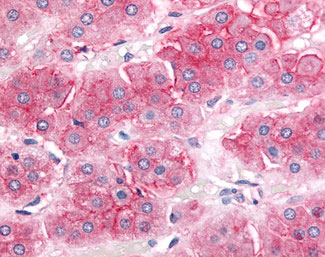ABCB1 / MDR1 / P Glycoprotein Antibody (Cytoplasmic Domain)
Rabbit Polyclonal Antibody
- SPECIFICATION
- CITATIONS
- PROTOCOLS
- BACKGROUND

Application
| IHC-P |
|---|---|
| Primary Accession | P08183 |
| Reactivity | Human |
| Host | Rabbit |
| Clonality | Polyclonal |
| Calculated MW | 141kDa |
| Dilution | IHC-P (20 µg/ml) |
| Gene ID | 5243 |
|---|---|
| Other Names | Multidrug resistance protein 1, 3.6.3.44, ATP-binding cassette sub-family B member 1, P-glycoprotein 1, CD243, ABCB1, MDR1, PGY1 |
| Target/Specificity | Human ABCB1 / MDR1. BLAST analysis of the peptide immunogen showed no homology with other human proteins. |
| Reconstitution & Storage | Long term: -70°C; Short term: +4°C |
| Precautions | ABCB1 / MDR1 / P Glycoprotein Antibody (Cytoplasmic Domain) is for research use only and not for use in diagnostic or therapeutic procedures. |
| Name | ABCB1 (HGNC:40) |
|---|---|
| Synonyms | MDR1, PGY1 |
| Function | Translocates drugs and phospholipids across the membrane (PubMed:2897240, PubMed:35970996, PubMed:8898203, PubMed:9038218, PubMed:35507548). Catalyzes the flop of phospholipids from the cytoplasmic to the exoplasmic leaflet of the apical membrane. Participates mainly to the flop of phosphatidylcholine, phosphatidylethanolamine, beta-D-glucosylceramides and sphingomyelins (PubMed:8898203). Energy-dependent efflux pump responsible for decreased drug accumulation in multidrug-resistant cells (PubMed:2897240, PubMed:35970996, PubMed:9038218). |
| Cellular Location | Cell membrane; Multi-pass membrane protein {ECO:0000255|PROSITE-ProRule:PRU00441} Apical cell membrane. Cytoplasm Note=ABCB1 localization is influenced by C1orf115 expression levels (plasma membrane versus cytoplasm). Localized to the apical membrane of enterocytes (PubMed:28408210). |
| Tissue Location | Expressed in small intestine (PubMed:28408210). Expressed in liver, kidney and brain. |
| Volume | 100 µl |

Thousands of laboratories across the world have published research that depended on the performance of antibodies from Abcepta to advance their research. Check out links to articles that cite our products in major peer-reviewed journals, organized by research category.
info@abcepta.com, and receive a free "I Love Antibodies" mug.
Provided below are standard protocols that you may find useful for product applications.
Background
Energy-dependent efflux pump responsible for decreased drug accumulation in multidrug-resistant cells.
References
Chen C.-J.,et al.Cell 47:381-389(1986).
Chen C.-J.,et al.J. Biol. Chem. 265:506-514(1990).
Chen G.,et al.J. Biol. Chem. 272:5974-5982(1997).
Jiang Y.,et al.Submitted (JUN-2008) to the EMBL/GenBank/DDBJ databases.
Ota T.,et al.Nat. Genet. 36:40-45(2004).
If you have used an Abcepta product and would like to share how it has performed, please click on the "Submit Review" button and provide the requested information. Our staff will examine and post your review and contact you if needed.
If you have any additional inquiries please email technical services at tech@abcepta.com.













 Foundational characteristics of cancer include proliferation, angiogenesis, migration, evasion of apoptosis, and cellular immortality. Find key markers for these cellular processes and antibodies to detect them.
Foundational characteristics of cancer include proliferation, angiogenesis, migration, evasion of apoptosis, and cellular immortality. Find key markers for these cellular processes and antibodies to detect them. The SUMOplot™ Analysis Program predicts and scores sumoylation sites in your protein. SUMOylation is a post-translational modification involved in various cellular processes, such as nuclear-cytosolic transport, transcriptional regulation, apoptosis, protein stability, response to stress, and progression through the cell cycle.
The SUMOplot™ Analysis Program predicts and scores sumoylation sites in your protein. SUMOylation is a post-translational modification involved in various cellular processes, such as nuclear-cytosolic transport, transcriptional regulation, apoptosis, protein stability, response to stress, and progression through the cell cycle. The Autophagy Receptor Motif Plotter predicts and scores autophagy receptor binding sites in your protein. Identifying proteins connected to this pathway is critical to understanding the role of autophagy in physiological as well as pathological processes such as development, differentiation, neurodegenerative diseases, stress, infection, and cancer.
The Autophagy Receptor Motif Plotter predicts and scores autophagy receptor binding sites in your protein. Identifying proteins connected to this pathway is critical to understanding the role of autophagy in physiological as well as pathological processes such as development, differentiation, neurodegenerative diseases, stress, infection, and cancer.


